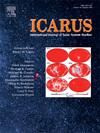Enhancing lunar DEM data using super-resolution techniques and optimizing the faster R-CNN network for sub-kilometer crater detection
IF 2.5
2区 物理与天体物理
Q2 ASTRONOMY & ASTROPHYSICS
引用次数: 0
Abstract
Meteorite impact craters are the most prominent geomorphological features on the lunar surface, playing a crucial role in studying lunar geological characteristics, evolution, and the selection of landing sites for spacecraft. However, due to the resolution limitations of global lunar Digital Elevation Models (DEM), existing DEM-based automatic crater detection methods struggle to identify small craters effectively. This paper proposes an SR-Net method based on super-resolution techniques to address this challenge to enhance lunar DEM image features. We combine this method with an improved Faster R-CNN algorithm to efficiently detect small craters. We used the Robbins database for training and testing, and we evaluated the model's performance for detecting craters with diameters greater than 1 km. Experimental results showed that the improved model achieved a recall rate of 81.2 %, a precision of 76 %, and an F1 score of 78.5 % on the test set. In the 4× super-resolved DEM images, we detected some small craters, less than 1 km in diameter, in the Change-5 landing area that were not recorded in the Robbins database. After manual inspection by four experts, the average false positive rate(FPR) for small craters that were more prominent than 500 m in diameter was 10 %, while the false positive rate for craters more prominent than 700 m dropped to 5 %. The results demonstrate that the proposed method significantly improves the detection of small craters, particularly in low-resolution scenarios, providing a viable solution for small crater detection tasks.
求助全文
约1分钟内获得全文
求助全文
来源期刊

Icarus
地学天文-天文与天体物理
CiteScore
6.30
自引率
18.80%
发文量
356
审稿时长
2-4 weeks
期刊介绍:
Icarus is devoted to the publication of original contributions in the field of Solar System studies. Manuscripts reporting the results of new research - observational, experimental, or theoretical - concerning the astronomy, geology, meteorology, physics, chemistry, biology, and other scientific aspects of our Solar System or extrasolar systems are welcome. The journal generally does not publish papers devoted exclusively to the Sun, the Earth, celestial mechanics, meteoritics, or astrophysics. Icarus does not publish papers that provide "improved" versions of Bode''s law, or other numerical relations, without a sound physical basis. Icarus does not publish meeting announcements or general notices. Reviews, historical papers, and manuscripts describing spacecraft instrumentation may be considered, but only with prior approval of the editor. An entire issue of the journal is occasionally devoted to a single subject, usually arising from a conference on the same topic. The language of publication is English. American or British usage is accepted, but not a mixture of these.
 求助内容:
求助内容: 应助结果提醒方式:
应助结果提醒方式:


